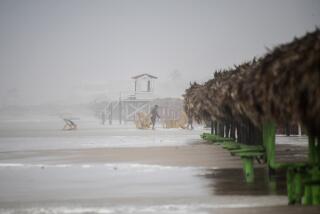Naming a winter storm? Meteorologists are appalled by Nemo
BOSTON -- Meteorologists might not be sure whether the storm heading into the East Coast will drop 12 inches or 24, but they are sure about one thing – this storm is definitely, absolutely, not called Nemo.
But that’s what the Weather Channel has decided to call it, part of a policy announced in the fall in which the TV station will give names to winter storms so that people can more easily follow them.
It’s angered a few meteorologists, and has spurred a Facebook page, “STOP the Weather Channel from naming winter storms.”
PHOTOS: Winter storm hits Northeast
“A named storm should be a hurricane, and only a hurricane” George Wright, a meteorologist and the founder of Wright Weather Consulting in New York, said in an interview with The Times. “A hurricane is something that’s more unusual and devastating. If you start naming other storms, people will suddenly think this might be a hurricane.”
Joel Meyer, founder and president of AccuWeather, a Weather Channel competitor, issued a statement this fall blasting the Weather Channel for its decision.
“In unilaterally deciding to name winter storms, the Weather Channel has confused media spin with science and public safety,” he said. “We have explored this issue for 20 years and have found that this is not good science and will mislead the public. Winter storms are very different from hurricanes.”
Flip over to the Weather Channel, though, and it’s Nemo-mania. There are graphics about Nemo’s trajectory, stories about Nemo, and a section where viewers can upload their own Nemo photos (of the storm, not the Disney movie).
The Weather Channel decided to start naming storms after it coined a 2011 event Snowtober, a name that got picked up on Twitter and in media outlets and drew more viewers to the site. The channel decided that naming a storm was helpful for those following the storm on social media, and also helped viewers keep track of weather events, said Brian Norcross, senior executive director of weather content and presentation at the Weather Channel.
“We know that when a tropical system is named, people pay more attention,” he said in an interview. “They go out and figure out what is going on -- what does it mean to them.”
Americans first started naming tropical storms in the 1940s, when Marines in the Pacific had to figure out a way to keep track of all the incoming and outgoing storms. The practice stuck, and in 1950, the National Hurricane Center started attaching names to storm advisories. (At first, storms were only named after women, but in 1979, forecasters began alternating between men’s and women’s names.)
But there are about 20 tropical storms a year, making it relatively easy to decide when to name a hurricane. However there are dozens of storms every week in the United States, bringing snow, rain, tornadoes and hail to all 50 states. If you ask the Weather Channel, winter storm Orko is currently making its way through Colorado.
So how do they choose what storms to name?
“It would have to be something disruptive” to travel and other plans, Norcross said.
Norcross supervised the creation of this year’s list of winter storm names, which also include Draco, Gandolf and Walda. While the Weather Channel first looked at using baby names from the early 20thcentury, it eventually settled on names of gods from Norse and other mythologies. Jorel, the father of Superman, nearly made the list, but was swapped out at the last minute for Jove.
“It’s not going to last,” predicted Wright, the meteorologist.
When asked about the controversy over the change, Norcross seemed unfazed.
“First of all, some people don’t like change,” he said. “And some people don’t use Twitter.”
But even Twitter users are divided over the use of the name. The New York mayor’s office has fully embraced “Nemo,” tweeting “Fun fact: There are 6,300 street miles in New York City to be plowed and salted -- that’s like going from NYC to LA and back. #Nemo.” Katie Couric went for both #Nemo and #Blizzard in her tweets, while Time and Slate used #Nemo.
CNN, Fox News and USA Today seemed happy to stick with #Blizzard for now, and some users pledged to never call the blizzard by its given name.
But it’s possible a new, organic name will pop up, as it did for Snowmageddon in 2010. How about #Blizzam? #sNOw school today? #The-Blizzard-Who-Must-Not-Be-Named?
ALSO:
Sandy-Stricken New York braces for blizzard
Record snowfall predict as blizzard approaches Northeast
Duke fraternity that held party mocking Asians is suspended
More to Read
Sign up for Essential California
The most important California stories and recommendations in your inbox every morning.
You may occasionally receive promotional content from the Los Angeles Times.










